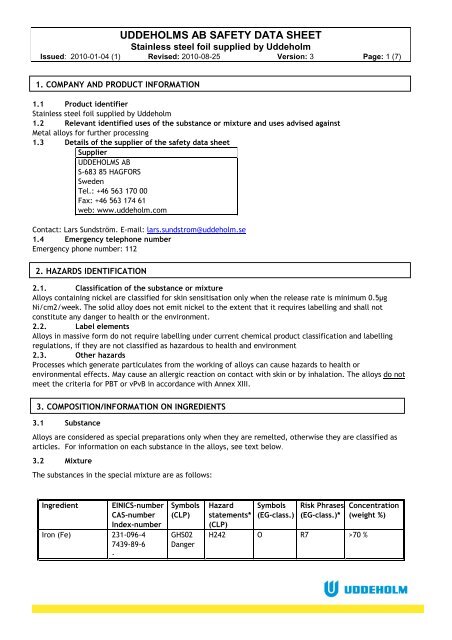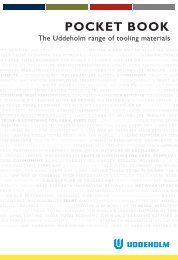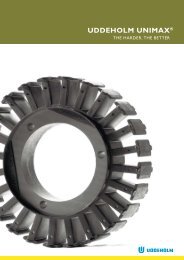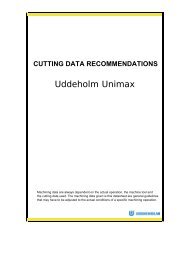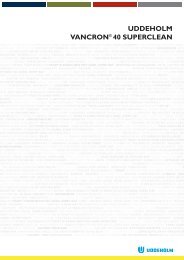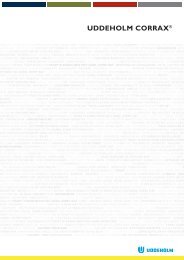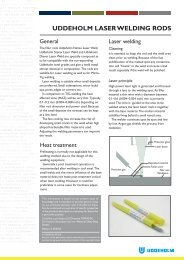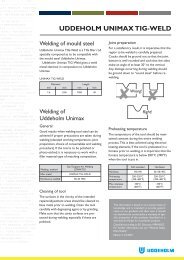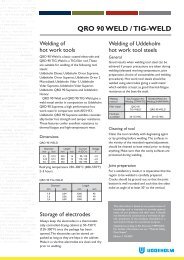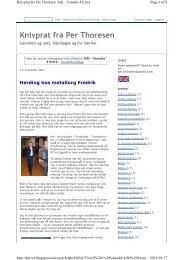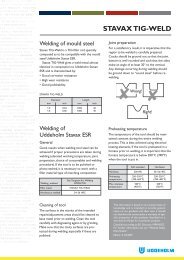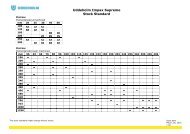MSDS Stainless steel foil supplied by Uddeholm
MSDS Stainless steel foil supplied by Uddeholm
MSDS Stainless steel foil supplied by Uddeholm
Create successful ePaper yourself
Turn your PDF publications into a flip-book with our unique Google optimized e-Paper software.
UDDEHOLMS AB SAFETY DATA SHEET<br />
<strong>Stainless</strong> <strong>steel</strong> <strong>foil</strong> <strong>supplied</strong> <strong>by</strong> <strong>Uddeholm</strong><br />
Issued: 2010-01-04 (1) Revised: 2010-08-25 Version: 3 Page: 1 (7)<br />
1. COMPANY AND PRODUCT INFORMATION<br />
1.1 Product identifier<br />
<strong>Stainless</strong> <strong>steel</strong> <strong>foil</strong> <strong>supplied</strong> <strong>by</strong> <strong>Uddeholm</strong><br />
1.2 Relevant identified uses of the substance or mixture and uses advised against<br />
Metal alloys for further processing<br />
1.3 Details of the supplier of the safety data sheet<br />
Supplier<br />
UDDEHOLMS AB<br />
S-683 85 HAGFORS<br />
Sweden<br />
Tel.: +46 563 170 00<br />
Fax: +46 563 174 61<br />
web: www.uddeholm.com<br />
Contact: Lars Sundström. E-mail: lars.sundstrom@uddeholm.se<br />
1.4 Emergency telephone number<br />
Emergency phone number: 112<br />
2. HAZARDS IDENTIFICATION<br />
2.1. Classification of the substance or mixture<br />
Alloys containing nickel are classified for skin sensitisation only when the release rate is minimum 0.5µg<br />
Ni/cm2/week. The solid alloy does not emit nickel to the extent that it requires labelling and shall not<br />
constitute any danger to health or the environment.<br />
2.2. Label elements<br />
Alloys in massive form do not require labelling under current chemical product classification and labelling<br />
regulations, if they are not classified as hazardous to health and environment<br />
2.3. Other hazards<br />
Processes which generate particulates from the working of alloys can cause hazards to health or<br />
environmental effects. May cause an allergic reaction on contact with skin or <strong>by</strong> inhalation. The alloys do not<br />
meet the criteria for PBT or vPvB in accordance with Annex XIII.<br />
3. COMPOSITION/INFORMATION ON INGREDIENTS<br />
3.1 Substance<br />
Alloys are considered as special preparations only when they are remelted, otherwise they are classified as<br />
articles. For information on each substance in the alloys, see text below.<br />
3.2 Mixture<br />
The substances in the special mixture are as follows:<br />
Ingredient EINICS-number<br />
CAS-number<br />
Index-number<br />
Iron (Fe) 231-096-4<br />
7439-89-6<br />
-<br />
Symbols<br />
(CLP)<br />
GHS02<br />
Danger<br />
Hazard<br />
statements*<br />
(CLP)<br />
Symbols<br />
(EG-class.)<br />
Risk Phrases<br />
(EG-class.)*<br />
H242 O R7 >70 %<br />
Concentration<br />
(weight %)
UDDEHOLMS AB SAFETY DATA SHEET<br />
<strong>Stainless</strong> <strong>steel</strong> <strong>foil</strong> <strong>supplied</strong> <strong>by</strong> <strong>Uddeholm</strong><br />
Issued: 2010-01-04 (1) Revised: 2010-08-25 Version: 3 Page: 2 (7)<br />
Chromium (Cr) 231-157-5<br />
7440-47-3<br />
-<br />
Nickel (Ni) 231-111-4<br />
7440-02-0<br />
028-002-00-7<br />
GHS06<br />
GHS09<br />
Danger<br />
GHS06<br />
GHS08<br />
Danger<br />
H300<br />
H310<br />
H332<br />
H410<br />
H317<br />
H331<br />
H351<br />
N, F R27/28 20<br />
50 53<br />
T<br />
R40-43-<br />
48/23<br />
15-20%<br />
8-12%<br />
*For complete wording of R-phrases and hazard statements see section 16.<br />
4. FIRST AID MEASURES<br />
4.1 Description of first aid measures<br />
Show this safety data sheet to the doctor on duty.<br />
4.1.1. Relevant routes of exposure<br />
Inhalation<br />
If dust, fumes or mist inhaled, remove patient to fresh air, allow to rest and keep warm.<br />
Skin contact<br />
Immediately remove any metal fragments or pieces that get under the skin. Wash well with plenty of soap<br />
and water following any contact with metal particles. Seek medical attention if irritation develops.<br />
Eye contact<br />
Avoid getting finely divided particles in the eyes. Flush immediately with plenty of luke-warm water, keeping<br />
eyelids open. Seek medical attention if symptoms persist.<br />
Ingestion<br />
Alloys in massive form are not hazardous, but should be kept out of the mouth. Finely divided particles may<br />
be easily ingested along with food, drink or smoking. If large quantities ingested, seek medical advice.<br />
4.2. Most important symptoms and effects<br />
The alloys in themselves or particles from the alloy are not judged as acute toxic. From the medical point of view,<br />
there is no evidence to indicate an absolute or a sharp distinction between harmful and non harmful content. An<br />
average content in the air of a single substance at the level of the limit considered, with current knowledge,<br />
generally not present any risk of injury or discomfort. It is nevertheless important to strive to keep all air pollutants<br />
as low as possible during the exposure limit. A particularly important situation is that if someone is exposed to<br />
multiple air pollutants simultaneously or exposed to air pollution related to heavy work. Keep dust levels below the<br />
limits mentioned in section 8.1.<br />
4.3. Indication of any immediate medical attention and special treatment needed<br />
There is no indication of immediate medical attention or special treatment documented for the alloys.
UDDEHOLMS AB SAFETY DATA SHEET<br />
<strong>Stainless</strong> <strong>steel</strong> <strong>foil</strong> <strong>supplied</strong> <strong>by</strong> <strong>Uddeholm</strong><br />
Issued: 2010-01-04 (1) Revised: 2010-08-25 Version: 3 Page: 3 (7)<br />
5. FIRE-FIGHTING MEASURES<br />
5.1. Extinguishing media<br />
The alloys are non-combustible.<br />
Where metal dust or powder is involved, cover with dry sand, chemical powder, or other dry inert material to<br />
minimise the risk of explosion. DO NOT use water.<br />
5.2. Special hazards arising from the substance or mixture<br />
Finely divided iron can explode in contact with air. Solid iron will react with oxidising materials, fluorine,<br />
chlorine, chlorine trifluoride, hydrogen peroxide, etc. Finely divided chromium can explode in contact with<br />
air. Solid will react with bromine pentafluoride. Finely divided chromium will react with carbon dioxide,<br />
nitrogen oxides, sulphur dioxide.<br />
5.3. Advice for fire-fighter<br />
Use ordinary safety equipment.<br />
6. ACCIDENTAL RELEASE MEASURES<br />
6.1. Personal precautions, protective equipment and emergency procedures<br />
Not applicable to solid metal/alloys in massive form. In particulate form, wear personal protective<br />
equipment as specified in Section 8. Avoid contact with the skin. Do not inhale dust.<br />
6.2. Environmental precautions<br />
Collect powder using a vacuum cleaner or <strong>by</strong> gentle sweeping to keep dust away from drains, surface and<br />
ground water. Prevent particulates from entering watercourses or drains. Avoid formation of dust clouds.<br />
6.3. Methods and material for containment and cleaning up<br />
Not applicable to solid metal/alloys in massive form.<br />
Collect powder using a vacuum cleaner or <strong>by</strong> gentle sweeping.<br />
In molten state: dam up the leaked material with dry sand or road salt. Do not shovel or use hand tools to<br />
affect the molten metal flow.<br />
6.4. Reference to other sections<br />
See also section 8.2.7.<br />
7. HANDLING AND STORAGE<br />
7.1 Precautions for safe handling<br />
No special precautions necessary for alloys in massive form other than normal physical handling techniques.<br />
Extraction should be used when working with particulate material (dust, fumes, mist). Avoid prolonged<br />
inhalation of dust. Wear gloves to avoid contact with skin (see Section 8). Working areas should be provided<br />
with extraction. Factories should be kept clean to avoid any unnecessary contamination.<br />
Do not to eat, drink and smoke in work areas and wash hands/shower when leaving the working areas.<br />
7.2. Conditions for safe storage, including any incompatibilities<br />
Store in a dry environment.<br />
7.3 Specific end use(s)<br />
See section 13.
UDDEHOLMS AB SAFETY DATA SHEET<br />
<strong>Stainless</strong> <strong>steel</strong> <strong>foil</strong> <strong>supplied</strong> <strong>by</strong> <strong>Uddeholm</strong><br />
Issued: 2010-01-04 (1) Revised: 2010-08-25 Version: 3 Page: 4 (7)<br />
8. EXPOSURE CONTROLS/PERSONAL PROTECTION<br />
8.1. Control parameters<br />
All over 8 hour period unless otherwise stated. Monitoring procedures are not required.<br />
Chromium UK WEL* 0.5mg/m 3 total<br />
Sweden NGV* 0.5mg/m 3 total<br />
5mg/m 3 respirable<br />
Nickel UK WEL 0.5mg/m 3 total<br />
Sweden NGV 0.5mg/m 3 total<br />
Sweden NGV 0.2mg/m 3 total<br />
*Workplace exposure limits in UK and Sweden.<br />
8.2 Exposure control<br />
Always check the applicability of any protective equipment with your supplier.<br />
8.2.1 Eye/face protection<br />
Always wear eye protection when handling dusts and other particulates, eg safety glasses with side<br />
protection, safety goggles or visor<br />
8.2.2 Skin protection<br />
Always wear protective clothing when handling dusts and other particulates.<br />
8.2.3 Hand protection<br />
Wear hand protection, eg leather gloves when handling alloys with sharp edges to avoid cuts. Always wear<br />
disposable nitrile or vinyl gloves when handling particulate material to avoid skin contact. Where necessary<br />
wear the disposable gloves under work gloves to protect against both types of hazard.<br />
8.2.4 Respiratory protection<br />
Alloys in delivered in solid form give no health risk through inhalation. Extraction should be used when<br />
working with particulate material (dust, fumes, mist). In case of prolonged or frequent exposure to<br />
particulates, wear particle filter mask (P3).<br />
8.2.5 General hygiene measures<br />
Wash hands well with soap and water after handling dusty materials. Wash contaminated clothing to avoid<br />
secondary contamination or contamination of other personnel.<br />
8.2.6 Thermal hazards<br />
Ensure adequate ventilation to keep levels of air-borne particles below occupational exposure limits given<br />
above. Working areas should be provided with extraction. Factories should be kept clean to avoid any<br />
unnecessary contamination.<br />
8.2.7 Environmental exposure control<br />
Avoid letting dust and fumes entering the outside air.<br />
9. PHYSICAL AND CHEMICAL PROPERTIES<br />
9.1. Information on basic physical and chemical properties<br />
Apearance: Silver gray metallic, alloy in massive form<br />
Odour: Odurless<br />
Melting point / freezing point: 1200 -1500 0 C<br />
Vapour density: 7.8 kg/dm 3<br />
Note: These are typical values and do not constitute a specification.<br />
9.2. Other information<br />
No other physical or chemical parameters are necessary for the alloys.
UDDEHOLMS AB SAFETY DATA SHEET<br />
<strong>Stainless</strong> <strong>steel</strong> <strong>foil</strong> <strong>supplied</strong> <strong>by</strong> <strong>Uddeholm</strong><br />
Issued: 2010-01-04 (1) Revised: 2010-08-25 Version: 3 Page: 5 (7)<br />
10. STABILITY AND REACTIVITY<br />
10.1. Reactivity<br />
Alloys are stable. Any reaction should not take place under normal circumstances.<br />
10.2. Chemical stability<br />
Alloys are stable. Corrosion should not take place under normal circumstances.<br />
10.3. Possibility of hazardous reactions<br />
See section 5.2.<br />
10.4. Conditions to avoid<br />
No special conditions need to be avoided for the alloys, however keep dust and fumes from entering the<br />
environment.<br />
10.5. Incompatible materials<br />
Contact with acids can generate explosive gasses, eg hydrogen.<br />
10.6. Hazardous decomposition products<br />
The alloys are stable.<br />
11. TOXICOLOGICAL INFORMATION<br />
11.1. Information on toxicological effects<br />
Alloys contain nickel which carry a risk of producing an allergic reaction following prolonged contact or in already<br />
sensitised persons. No further toxicological data available for the alloys. See below for LD50 or LC50 for the<br />
individual substances, since no LC50 or LD50 has been established for the mixture as a whole.<br />
Chromium - Oral LD 50 rat 19.8 mg/kg bodyweight (highly toxic)<br />
Nickel- Oral LD 50 rat<br />
1500 mg/kg bodyweight<br />
Iron - Oral LD 50 rat 30000 mg/kg bodyweight (not harmful)<br />
12. ECOLOGICAL INFORMATION<br />
12.1. Toxicity<br />
Alloys contain metals which are considered to be very toxic towards aquatic organisms. Finely divided alloys<br />
are therefore considered harmful to aquatic organisms.<br />
12.2. Persistence and degradability<br />
The alloys consist of elements that can not degrade any further in the environment.<br />
12.3. Bioaccumulative potential<br />
Alloys contain heavy metals which bioaccumulate in the food chain. The following figures are the<br />
bioconcentration factor (BCF) for the substances on their own:<br />
Iron, BCF: 140000<br />
Chromium, BCF: 200<br />
Nickel, BCF: 16<br />
12.4. Mobility in soil<br />
Metal alloys are not soluble in water or soil. Particles formed <strong>by</strong> working alloys can be transported in the air.<br />
12.5. Results of PBT and vPvB assessment<br />
No chemical saftey report is required for the alloys, however neither the alloys in itself or the substances that<br />
it consist of, meet the criteria for PBT or vPvB in accordance with REACH, Annex XIII.<br />
12.6. Other adverse effects<br />
In massive form alloys present no hazards to the aquatic environment. Particles and ions can, never the less,<br />
enter the aquatic compartment <strong>by</strong> means of dusts or smoke, or <strong>by</strong> liberation due to erosion there<strong>by</strong><br />
introducing iron or heavy metals into the ground or water.
UDDEHOLMS AB SAFETY DATA SHEET<br />
<strong>Stainless</strong> <strong>steel</strong> <strong>foil</strong> <strong>supplied</strong> <strong>by</strong> <strong>Uddeholm</strong><br />
Issued: 2010-01-04 (1) Revised: 2010-08-25 Version: 3 Page: 6 (7)<br />
13. DISPOSAL CONSIDERATIONS<br />
13.1. Waste treatment methods<br />
Non-contaminated waste from the production and pure-grade- alloys are recyclable. The unused product (massive<br />
alloy) is not classified as hazardous waste. Dispose in accordance with appropriate government regulations.Any<br />
residues of finely divided product (particles, dust, fumes) are regarded as Hazardous Waste. Contact your local<br />
entrepreneur for advice.<br />
14. TRANSPORT INFORMATION<br />
14.1. UN number<br />
Alloys in massive form are not classified as dangerous goods for transport and has no UN number.<br />
14.2. UN proper shipping name<br />
Alloys in massive form are not classified as dangerous goods for transport and has no UN proper shipping name<br />
14.3. Transport hazard class(es)<br />
Alloys in massive form are not classified as dangerous goods for transport.<br />
14.4. Packing group<br />
There are not any special precautions with which a user should or must comply or be aware of in connection<br />
with transport or conveyance either within or outside his premises.<br />
14.5. Environmental hazards<br />
The alloys are not environmentally hazardous according to the criteria of the UN Model Regulations (as<br />
reflected in the IMDG Code, ADR, RID and ADN) and/or a marine pollutant according to the IMDG Code.<br />
14.6. Special precautions for user<br />
There are not any special precautions which a user should or must comply or be aware of in connection with<br />
transport or conveyance either within or outside his premises of the alloys.<br />
14.7. Transport in bulk according to Annex II of MARPOL73/78 and the IBC Code<br />
Alloys in massive form do not subject under MARPOL73/78 and the IBC Code.<br />
15. REGULATORY INFORMATION<br />
15.1. Safety, health and environmental regulations/legislation specific for the substance or mixture<br />
Prepared according to EU Directives 1907/2006 (REACH) & 1272/2008 (CLP). Classifications mentioned in<br />
table 3.2 concerns substances in their crushed form. Alloys in massive form do not require labelling under<br />
current chemical product classification and labelling regulations, if they are not classified as hazardous to<br />
health and environment. Contains nickel and cobalt. Alloys in particulate form eg dust, fumes, mist may<br />
cause an allergic reaction on contact with skin or if inhaled.<br />
15.2. Chemical Safety Assessment<br />
No chemical safety assessment has been carried out for the product.<br />
16. OTHER INFORMATION<br />
16.1 Modifications since previous version<br />
Version 3: name change of company<br />
The information has been updated in sections.<br />
Key literature references and sources for data<br />
For this version has http://kemi.prevent.se/ (a chemical substances database which is a compilation of data<br />
from numerous sources) been used for information on individual substances.<br />
Full text of R-phrases used in Section 3
UDDEHOLMS AB SAFETY DATA SHEET<br />
<strong>Stainless</strong> <strong>steel</strong> <strong>foil</strong> <strong>supplied</strong> <strong>by</strong> <strong>Uddeholm</strong><br />
Issued: 2010-01-04 (1) Revised: 2010-08-25 Version: 3 Page: 7 (7)<br />
R7 May cause fire<br />
R20 Harmful <strong>by</strong> inhalation<br />
R27/28 Very toxic in contact with skin and if swallowed<br />
R40 Limited evidence of a carcinogenic effect<br />
R43 May cause sensitisation <strong>by</strong> skin contact<br />
R48/23 Toxic: danger of serious damage to health <strong>by</strong> prolonged exposure through inhalation<br />
R50 Very toxic to aquatic organisms<br />
R53 May cause long-term adverse effects in the aquatic environment<br />
Full text of Hazard statements used in Section3<br />
H242 Heating may cause a fire<br />
H300 Fatal if swallowed<br />
H310 Fatal in contact with skin<br />
H317 May cause an allergic skin reaction<br />
H331 Toxic if inhaled<br />
H332 Harmful if inhaled<br />
H351 Suspected of causing cancer<br />
H410 Very toxic to aquatic life with long lasting effects<br />
For any further information, please contact:<br />
UDDEHOLMS AB Tel.: +46 563 170 00<br />
S-683 85 HAGFORS Fax: +46 563 174 61<br />
Sweden<br />
web: www.uddeholm.com


